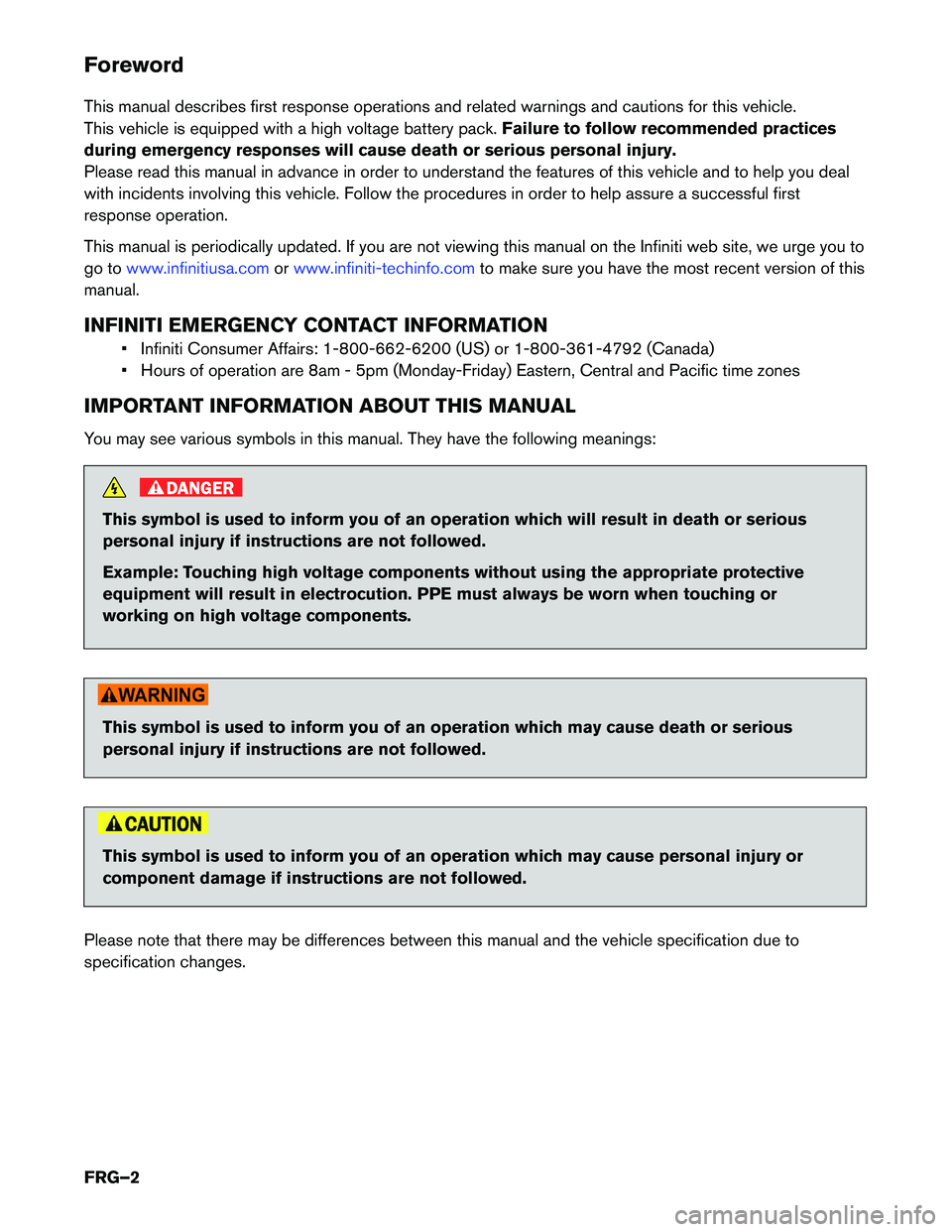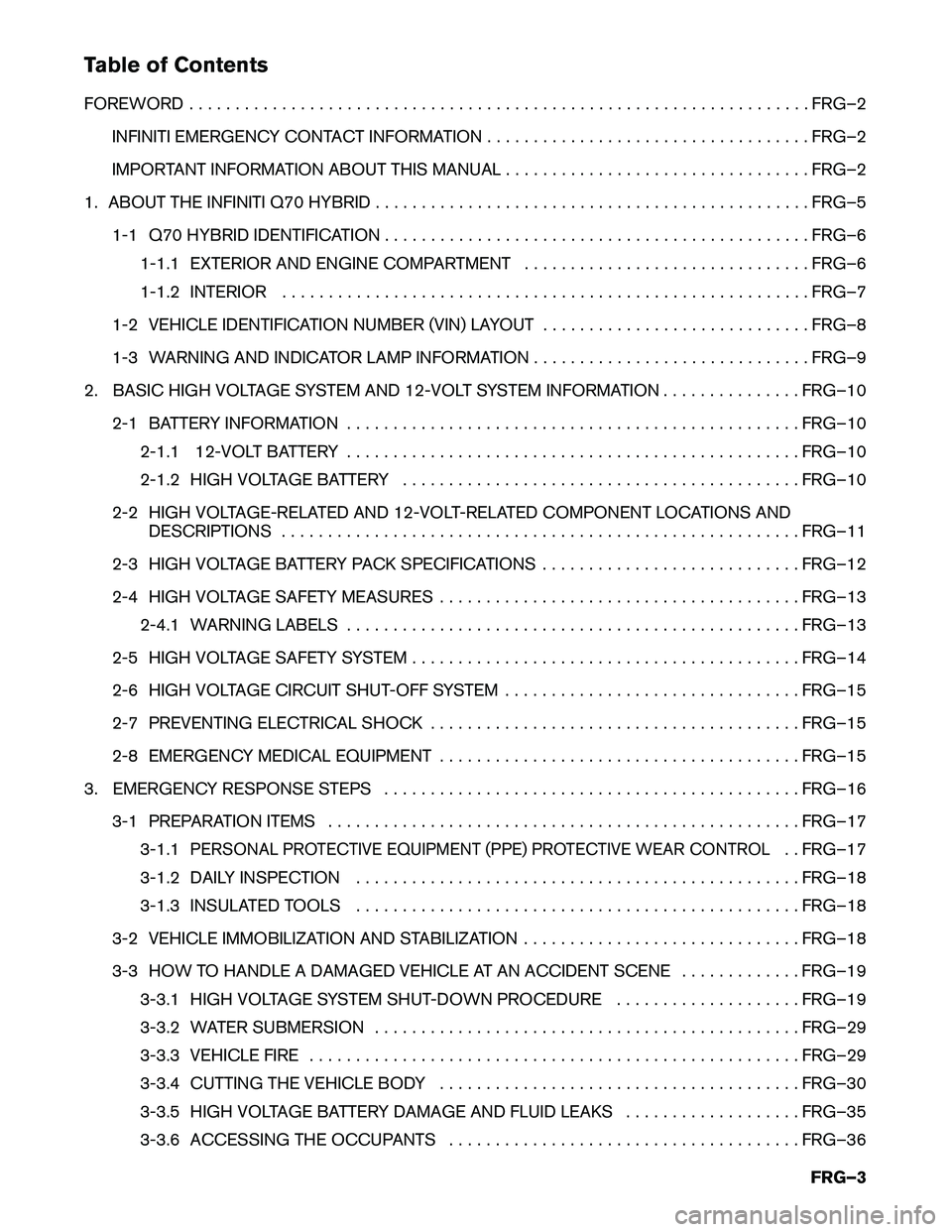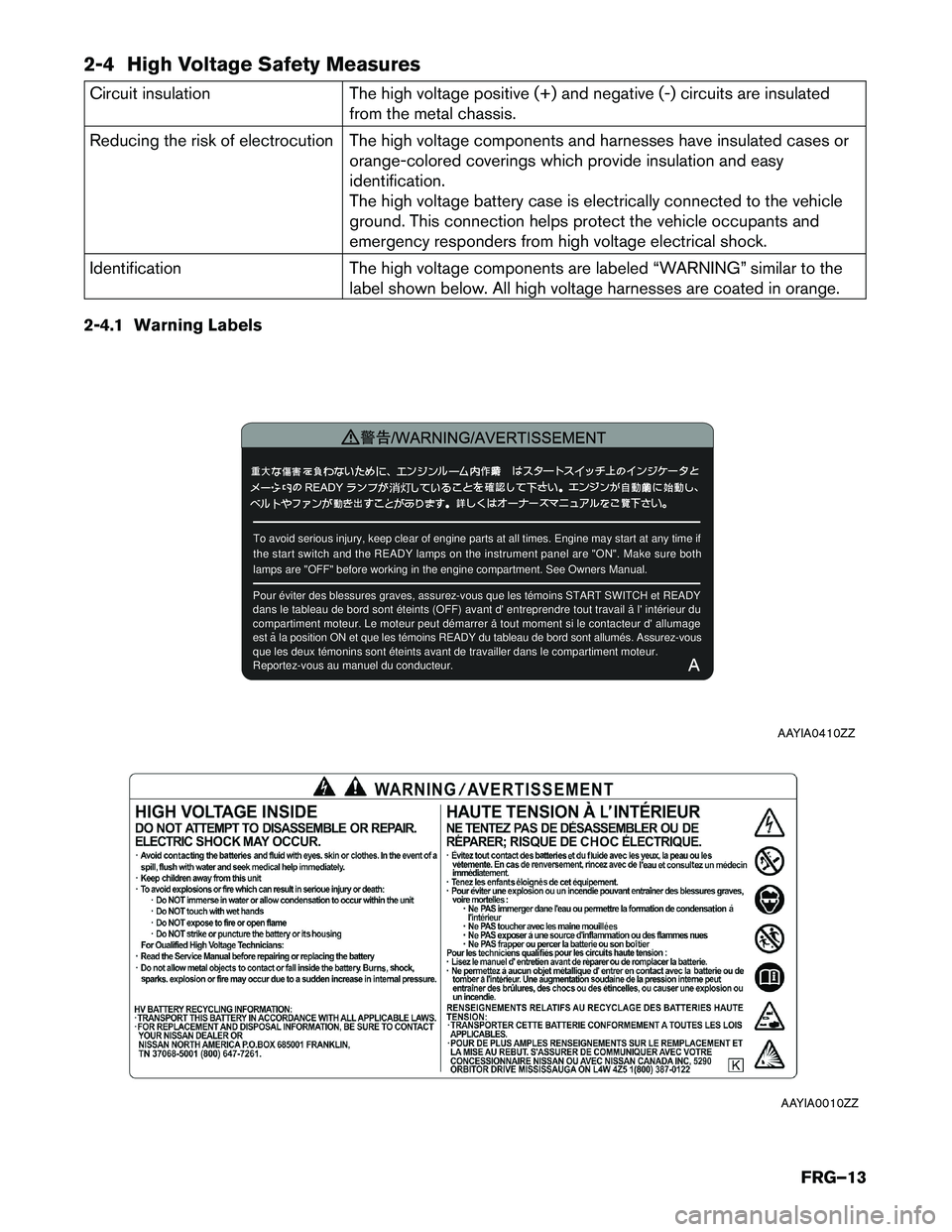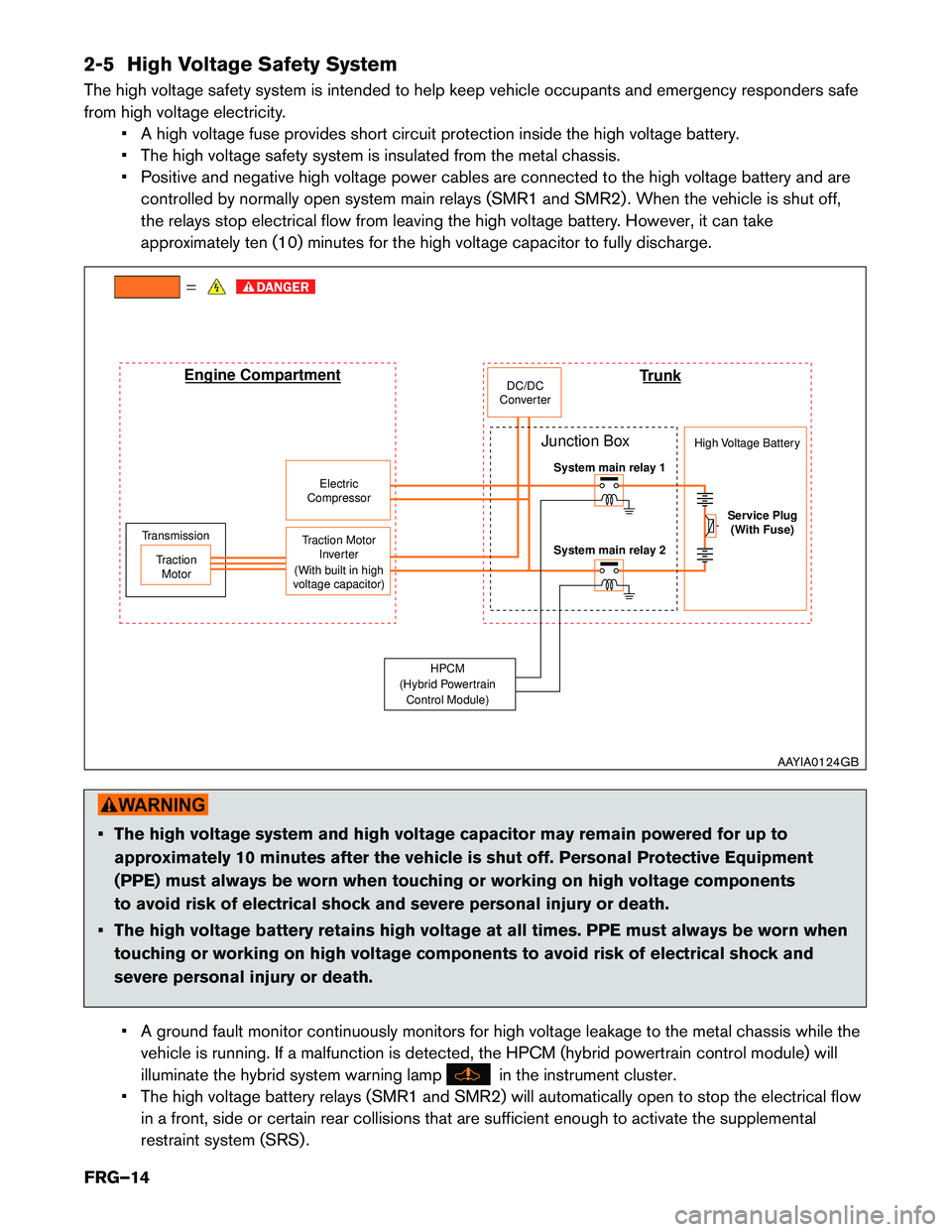2017 INFINITI Q70 HYBRID ESP
[x] Cancel search: ESPPage 1 of 42

2017 Q70 HYBRID
First Responder’s Guide
Page 2 of 42

Foreword
This
manual describes first response operations and related warnings and cautions for this vehicle.
This vehicle is equipped with a high voltage battery pack. Failure to follow recommended practices
during emergency responses will cause death or serious personal injury.
Please read this manual in advance in order to understand the features of this vehicle and to help you deal
with incidents involving this vehicle. Follow the procedures in order to help assure a successful first
response operation.
This manual is periodically updated. If you are not viewing this manual on the Infiniti web site, we urge you to
go to www.infinitiusa.com orwww.infiniti-techinfo.com to make sure you have the most recent version of this
manual.
INFINITI
EMERGENCY CONTACT INFORMATION
• Infiniti Consumer Affairs: 1-800-662-6200 (US) or 1-800-361-4792 (Canada)
• Hours of operation are 8am - 5pm (Monday-Friday) Eastern, Central and Pacific time zones
IMPORTANT INFORMATION ABOUT THIS MANUAL
You may see various symbols in this manual. They have the following meanings: DANGER
This symbol is used to inform you of an operation which will result in death or serious
personal
injury if instructions are not followed.
Example: Touching high voltage components without using the appropriate protective
equipment will result in electrocution. PPE must always be worn when touching or
working on high voltage components. This symbol is used to inform you of an operation which may cause death or serious
personal
injury if instructions are not followed. This symbol is used to inform you of an operation which may cause personal injury or
component
damage if instructions are not followed.
Please note that there may be differences between this manual and the vehicle specification due to
specification changes.
FRG–2
Page 3 of 42

Table of Contents
FOREWORD
. . . . . . . . . . . . . . . . . . . . . . . . . . . . . . . . . . . . . . . . . . . . . . . . . . . . . . . . . . . . . . . . . . . FRG–2
INFINITI EMERGENCY CONTACT INFORMATION . . . . . . . . . . . . . . . . . . . . . . . . . . . . . . . . . . . FRG–2
IMPORTANT INFORMATION ABOUT THIS MANUAL . . . . . . . . . . . . . . . . . . . . . . . . . . . . . . . . . FRG–2
1. ABOUT THE INFINITI Q70 HYBRID . . . . . . . . . . . . . . . . . . . . . . . . . . . . . . . . . . . . . . . . . . . . . . . FRG–5 1-1 Q70 HYBRID IDENTIFICATION . . . . . . . . . . . . . . . . . . . . . . . . . . . . . . . . . . . . . . . . . . . . . . FRG–61-1.1 EXTERIOR AND ENGINE COMPARTMENT . . . . . . . . . . . . . . . . . . . . . . . . . . . . . . . FRG–6
1-1.2 INTERIOR . . . . . . . . . . . . . . . . . . . . . . . . . . . . . . . . . . . . . . . . . . . . . . . . . . . . . . . . . FRG–7
1-2 VEHICLE IDENTIFICATION NUMBER (VIN) LAYOUT . . . . . . . . . . . . . . . . . . . . . . . . . . . . . FRG–8
1-3 WARNING AND INDICATOR LAMP INFORMATION . . . . . . . . . . . . . . . . . . . . . . . . . . . . . . FRG–9
2. BASIC HIGH VOLTAGE SYSTEM AND 12-VOLT SYSTEM INFORMATION . . . . . . . . . . . . . . . FRG–10 2-1 BATTERY INFORMATION . . . . . . . . . . . . . . . . . . . . . . . . . . . . . . . . . . . . . . . . . . . . . . . . . FRG–102-1.1 12-VOLT BATTERY . . . . . . . . . . . . . . . . . . . . . . . . . . . . . . . . . . . . . . . . . . . . . . . . . FRG–10
2-1.2 HIGH VOLTAGE BATTERY . . . . . . . . . . . . . . . . . . . . . . . . . . . . . . . . . . . . . . . . . . . FRG–10
2-2 HIGH VOLTAGE-RELATED AND 12-VOLT-RELATED COMPONENT LOCATIONS AND DESCRIPTIONS . . . . . . . . . . . . . . . . . . . . . . . . . . . . . . . . . . . . . . . . . . . . . . . . . . . . . . . . FRG–11
2-3 HIGH VOLTAGE BATTERY PACK SPECIFICATIONS . . . . . . . . . . . . . . . . . . . . . . . . . . . . FRG–12
2-4 HIGH VOLTAGE SAFETY MEASURES . . . . . . . . . . . . . . . . . . . . . . . . . . . . . . . . . . . . . . . FRG–13 2-4.1 WARNING LABELS . . . . . . . . . . . . . . . . . . . . . . . . . . . . . . . . . . . . . . . . . . . . . . . . . FRG–13
2-5 HIGH VOLTAGE SAFETY SYSTEM . . . . . . . . . . . . . . . . . . . . . . . . . . . . . . . . . . . . . . . . . . FRG–14
2-6 HIGH VOLTAGE CIRCUIT SHUT-OFF SYSTEM . . . . . . . . . . . . . . . . . . . . . . . . . . . . . . . . FRG–15
2-7 PREVENTING ELECTRICAL SHOCK . . . . . . . . . . . . . . . . . . . . . . . . . . . . . . . . . . . . . . . . FRG–15
2-8 EMERGENCY MEDICAL EQUIPMENT . . . . . . . . . . . . . . . . . . . . . . . . . . . . . . . . . . . . . . . FRG–15
3. EMERGENCY RESPONSE STEPS . . . . . . . . . . . . . . . . . . . . . . . . . . . . . . . . . . . . . . . . . . . . . FRG–16 3-1 PREPARATION ITEMS . . . . . . . . . . . . . . . . . . . . . . . . . . . . . . . . . . . . . . . . . . . . . . . . . . . FRG–173-1.1
PERSONAL PROTECTIVE EQUIPMENT (PPE) PROTECTIVE WEAR CONTROL. . FRG–17
3-1.2 DAILY INSPECTION . . . . . . . . . . . . . . . . . . . . . . . . . . . . . . . . . . . . . . . . . . . . . . . . FRG–18
3-1.3 INSULATED TOOLS . . . . . . . . . . . . . . . . . . . . . . . . . . . . . . . . . . . . . . . . . . . . . . . . FRG–18
3-2 VEHICLE IMMOBILIZATION AND STABILIZATION . . . . . . . . . . . . . . . . . . . . . . . . . . . . . . FRG–18
3-3 HOW TO HANDLE A DAMAGED VEHICLE AT AN ACCIDENT SCENE . . . . . . . . . . . . . FRG–19 3-3.1 HIGH VOLTAGE SYSTEM SHUT-DOWN PROCEDURE . . . . . . . . . . . . . . . . . . . . FRG–19
3-3.2 WATER SUBMERSION . . . . . . . . . . . . . . . . . . . . . . . . . . . . . . . . . . . . . . . . . . . . . . FRG–29
3-3.3 VEHICLE FIRE . . . . . . . . . . . . . . . . . . . . . . . . . . . . . . . . . . . . . . . . . . . . . . . . . . . . . FRG–29
3-3.4 CUTTING THE VEHICLE BODY . . . . . . . . . . . . . . . . . . . . . . . . . . . . . . . . . . . . . . . FRG–30
3-3.5 HIGH VOLTAGE BATTERY DAMAGE AND FLUID LEAKS . . . . . . . . . . . . . . . . . . . FRG–35
3-3.6 ACCESSING THE OCCUPANTS . . . . . . . . . . . . . . . . . . . . . . . . . . . . . . . . . . . . . . FRG–36
FRG–3
Page 13 of 42

2-4 High Voltage Safety Measures
Circuit insulation
The high voltage positive (+) and negative (-) circuits are insulated
from the metal chassis.
Reducing the risk of electrocution The high voltage components and harnesses have insulated cases or orange-colored coverings which provide insulation and easy
identification.
The high voltage battery case is electrically connected to the vehicle
ground. This connection helps protect the vehicle occupants and
emergency responders from high voltage electrical shock.
Identification The high voltage components are labeled “WARNING” similar to the
label shown below. All high voltage harnesses are coated in orange.
2-4.1 Warning Labels To avoid serious injury, keep clear of engine parts at all times. Engine\
may start at any time if
t
he start switch and the READY lamps on the instrument panel are "ON". Make sure both
lamps are "OFF" before working in the engine compartment. See Owners Man\
ual. ¾¯¸æ/WARNING/AVERTISSEMENT ÖØ ´ó
ÏûµÆ
Pour éviter des blessures graves, assurez-vous que les témoins STA\
RT SWITCH et READY
d
ans le tableau de bord sont éteints (OFF) avant d' entreprendre tout travail a l' intérieur du
compartiment moteur. Le moteur peut démarrer a tout moment si le contacteur d' allumage
est a la position ON et que les témoins READY du tableau de bord sont allumés. Assurez-vous
que les deux témonins sont éteints avant de travailler dans le com\
partiment moteur.
Reportez-vous au manuel du conducteur. ÉË º¦
¶¯³ö
Ïê ÀÀ
¸º
×÷ Òµ ʱ
È· ÈÏ ×Ô ¶¯ µÄʼ ¶¯ READY
A
AAYIA0410ZZ AAYIA0010ZZ
FRG–13
Page 14 of 42

2-5 High Voltage Safety System
The
high voltage safety system is intended to help keep vehicle occupants and emergency responders safe
from high voltage electricity. • A high voltage fuse provides short circuit protection inside the high voltage battery.
• The high voltage safety system is insulated from the metal chassis.
• Positive and negative high voltage power cables are connected to the high voltage battery and arecontrolled by normally open system main relays (SMR1 and SMR2) . When the vehicle is shut off,
the relays stop electrical flow from leaving the high voltage battery. However, it can take
approximately ten (10) minutes for the high voltage capacitor to fully discharge. • The high voltage system and high voltage capacitor may remain powered for up to
approximately
10 minutes after the vehicle is shut off. Personal Protective Equipment
(PPE) must always be worn when touching or working on high voltage components
to avoid risk of electrical shock and severe personal injury or death.
• The high voltage battery retains high voltage at all times. PPE must always be worn when touching or working on high voltage components to avoid risk of electrical shock and
severe personal injury or death.
• A ground fault monitor continuously monitors for high voltage leakage to the metal chassis while the vehicle is running. If a malfunction is detected, the HPCM (hybrid powertrain control module) will
illuminate the hybrid system warning lamp in the instrument cluster.
•
The high voltage battery relays (SMR1 and SMR2) will automatically open to stop the electrical flow
in a front, side or certain rear collisions that are sufficient enough to activate the supplemental
restraint system (SRS) . Trunk
J
unction Box High Voltage Battery
System main relay 1
Service Plug (With Fuse)
System main relay 2
Transmission
Traction Motor Traction Motor
Inverter
(With built in high
voltage capacitor) Electric
Compressor DC/DC
Converter
Engine Compartment
HPCM
(Hybrid Powertrain Control Module) AAYIA0124GB
FRG–14
Page 16 of 42

3. Emergency Response Steps
DANGER
• Failure to properly shut down the high voltage electrical system before the Emergency
Response Procedures are performed will result in serious injury or death from
electrical shock. To prevent serious injury or death, NEVER touch high voltage
harnesses or components with out always wearing appropriate Personal Protective
Equipment (PPE) . PPE must always be worn when touching or working on high
voltage components
• If it is necessary to touch any of the high voltage harnesses or components you must always wear appropriate PPE to avoid electrical shock. PPE must always be worn
when touching or working on high voltage components. Shut down the high voltage
system by following the steps outlined in 3-3.1 High Voltage System Shut-Down
Procedure
(FRG–19) Wait approximately ten (10) minutes for complete discharge of
the
high voltage capacitor after the high voltage system has been shut down. • NEVER assume the Q70 HYBRID is shut OFF simply because it is quiet.
• If the READY indicator is ON the high voltage system is active.
• If possible, be sure to check the READY indicator on the instrument cluster and
verify
that the READY indicator is OFF and the high voltage system is stopped.
FRG–16
Page 18 of 42

3-1.2 Daily Inspection
This
inspection is performed before and after use. The responder who will be using the items should
perform the inspection and check for deterioration and damage. • Insulated rubber gloves should be inspected for scratches, holes and tears. (Visual check and airleakage test)
• Insulated safety boots should be inspected for holes, damage, nails, metal pieces, wear or other problems on the soles. (Visual check)
• Insulated rubber sheet should be inspected for tears. (Visual check)
3-1.3 Insulated Tools
When performing work at locations where high voltage is applied (such as terminals) , use insulated tools
meeting 1,000V/300A specifications.
3-2 Vehicle Immobilization and Stabilization
Apply the parking brake and stabilize the vehicle with a wheel chock(s) or deflate the tires. Put support
material such as wooden blocks or utilize the Lift Airbag Equipment for rescue. To avoid electrical shock, do not put the Lift Airbag Equipment for rescue and wheel
chock(s)
under the high-voltage components and harnesses. AAYIA0016ZZ
FRG–18
Page 19 of 42

3-3 How to Handle a Damaged Vehicle at an Accident Scene
NO
TE:
If any air bags have deployed in the following 3 situations, the high-voltage (HV) system has
been designed to automatically shut off at the time of deployment.
The Infiniti Q70 HYBRID high-voltage system incorporates capacitors which are energized whenever the
high-voltage system is on. If the high-voltage system is shut down (either through one of the built-in
automatic mechanisms or manually through one of the procedures explained in this FRG) , the capacitors
will begin to gradually discharge. After 5 minutes, the voltage level will have dropped below 60V, and
complete discharge requires approximately 10 minutes after high-voltage system shut down. It is within this
period of time that responders must be most cautious.
When arriving to an incident involving an Infiniti Q70 HYBRID, the vehicle should be approached with
caution and inspected for the level of damage. In addition to overall vehicle condition (location and severity
of body damage, air bag deployment, etc.) , the high-voltage system should be assessed specifically. The
locations of the high-voltage component parts are illustrated in this FRG. Refer to 2-2 High Voltage-
Related
and 12-Volt-Related Component Locations and Descriptions (FRG–11) . Appropriate personal pro-
tective
equipment (PPE) must always be worn when approaching a vehicle of unknown condition, as
described in this FRG.
Situation 1) High voltage system intact, occupants can be accessed without extrication tools
The HV system can be shut down by following the procedure in this guide, while wearing appropriate PPE.
After HV system shut down, occupant assistance can begin immediately, and no wait period is necessary.
Situation 2) High voltage system intact, occupants cannot be accessed without extrication tools
The HV system can be shut down by following the procedure in this guide, while wearing appropriate PPE.
After HV system shut down, absolute care must be taken not to cut through or damage any HV system
wiring, battery or components within ten (10) minutes of HV system shut down, but occupant assistance
operations using extrication equipment can begin immediately. The locations of the HV components are
illustrated in this guide.
Situation 3) High-voltage (HV) system damaged
If there is any evidence that the HV system has been compromised (such as arcing/sparking, orange wiring
harnesses cut or damaged, HV component casings damaged, etc.) , the responder may still be at risk of
high voltage exposure. The vehicle must be approached with extreme caution prior to initiating any system
shut down procedures or rendering assistance to occupants. Appropriate PPE must always be worn as
described in this guide, and the ten (10) minute wait time must be observed after HV system shut down in
order to ensure the system is de-energized.
In rare situations where vehicle damage is very severe, HV system shut down procedures as described in
this guide may not work. In these instances extreme caution and appropriate risk management must be
followed to prevent shock or electrocution to the responder or occupant.
3-3.1 High Voltage System Shut-Down Procedure
Any of the following procedures can shut down the high voltage system. The first response operation should
only begin after shutting down the high voltage system. If the vehicle is heavily damaged, for example the
high voltage battery is deformed, broken or cracked, appropriate PPE must always be used and the high
voltage battery and high voltage components must not be touched.
FRG–19